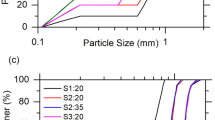Abstract
Behind a retaining wall, the mean effective stress mainly decreases during an excavation phase following an unloading stress path. The volumetric strains generated by purely elastic soils are systematically dilative which induces aberrant ground uplifts. The introduction of plasticity along with a nonlinear elastic domain turns out to be essential for a realistic prediction of ground movements. In this paper, a numerical analysis is carried out using a finite element code considering an advanced soil constitutive model called "Generalized Hardening Soil” which has been recently developed. This model contains the exact same set of features as the Hardening Soil Small Strain model but with the possibility to activate each of its plastic and nonlinear elastic mechanisms independently. The role of these mechanisms are investigated to assess their impact on the shape and the amplitude of the ground movements. Numerical results demonstrated that plasticity triggers the main contractive volumetric strains leading to settlements. Nevertheless it cannot fully compensate the elastic uplifts due to unloading. The insertion of strain dependent stiffness is essential as well as the stress dependency. A back analysis of the historical excavation of the Taipei National Enterprise Center permitted to validate these findings.




















Similar content being viewed by others
Data Availability
Enquiries about data availability should be directed to the authors.
References
Benz T (2007) Small-strain stiffness of soils and its numerical consequences, Institut für Geotechnik der Universität Stuttgart, 55, Ed Vermeer
Clough GW, O’Rourke TD (1990) Construction induced movements of in situ walls, design and performance of earth retaining structures. In: ASCE. Cornell University, pp 439–470
Dong Y (2014) Advanced finite element analysis of deep excavation case histories, Thesis in University of Oxford, Department of engineering science
El Arja H, Bourgeois E, Burlon S (2019) Accounting for plastic strain mechanism in calculations of deep excavations. In: 19th European conference on soil mechanics and geotechnical engineering, Iceland, Reykjavik
Gaba A, Hardy S, Doughty L, Powrie W, Selemetas D (2017) Chapter 6: Ground movements. In: Guidance on embedded retaining wall design, Ciria C760, pp 145–183
Ghorbani E, Khodaparast M (2023) Performance-based design for top-down system in the geotechnical conditions of Qom, Iran. Geotech Geol Eng 41:1855–1876
Haundi T, Nangulama HK, Mbewe VR (2023) Site characterisation, deep basement support, construction, and deformation control. Geotech Geol Eng. https://doi.org/10.1007/s10706-023-02634-y
Hardin BO, Drnevich VP (1972) Shear modulus and damping in soils: measurement and parameter effects. J Soil Mech Found Div Proc Am Soc Civ Eng 98(SM7):667–692
Hejazi Y (2010) Influence de la prise en compte des modules en petites déformations des sols sur la modélisation numérique d’ouvrages géotechniques, Mémoire de thèse, L’Institut National des Sciences Appliquées de Lyon
Hsieh PG, Ou CY (1998) Shape of ground surface settlement profiles caused by excavation. Can Geotech J 35:1004–1017
Houhou MN, Emeriault F, Belounar A (2019) Three-dimensional numerical back-analysis of a monitored deep excavation retained by strutted diaphragm walls. Tunn Undergr Space Technol 83:153–164
Kramer SL (1996) Geotechnical earthquake engineering. Prentice Hall
Kokusho T (1980) Cyclic triaxial test of dynamic soil properties for wide strain range. In: Soils and foundations, vol 20, no 2. Japanese Society of Soil Mechanics and Foundation Engineering
Kung TC, Ou CY, Juang CH (2009) Modelling small-strain behavior of Taipei clays for finite element analysis of braced excavations. Comput Geotech 36:304–319
Lam S (2010) Ground movements due to excavation in clay: physical and analytical models, thesis in University of Cambridge
Lim A, Hsieh PG, Ou CY (2016) Evaluation of buttress wall shapes to limit movements induced by deep excavation. Comput Geotech 78:155–170
Mayne PW, Kulhawy FH (1982) K0-OCR relationships in soil. J Geotech Eng Div Proc ASCE 108(GT6):851–869
Ou CY (2016) Finite element analysis of deep excavation problems. J Geoeng 11(1):1–12
Ou CY, Hsieh PG (2011) A simplified method for predicting ground settlement profiles induced by excavation in soft clay. Comput Geotech 38:987–997
Ou CY, Liao JT, Lin HD (1998) Performance of diaphragm wall using wall using top-down method. J Geotech Geoenviron Eng 798–808
Plaxis 2D (2017) Tutorial manual, reference manual, material models manual, scientific manual
Funding
The authors have not disclosed any funding.
Author information
Authors and Affiliations
Corresponding author
Ethics declarations
Conflict of interest
The authors have not disclosed any competing interests.
Additional information
Publisher's Note
Springer Nature remains neutral with regard to jurisdictional claims in published maps and institutional affiliations.
Rights and permissions
Springer Nature or its licensor (e.g. a society or other partner) holds exclusive rights to this article under a publishing agreement with the author(s) or other rightsholder(s); author self-archiving of the accepted manuscript version of this article is solely governed by the terms of such publishing agreement and applicable law.
About this article
Cite this article
Nejjar, K., Dias, D., Cuira, F. et al. Impact of the Nonlinear Soil Behavior on the Movements Prediction of Deep Excavations. Geotech Geol Eng (2024). https://doi.org/10.1007/s10706-024-02782-9
Received:
Accepted:
Published:
DOI: https://doi.org/10.1007/s10706-024-02782-9




